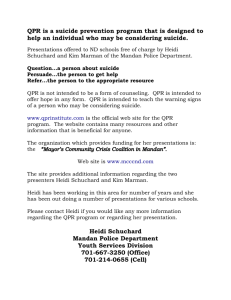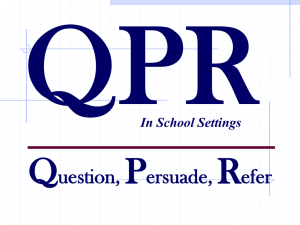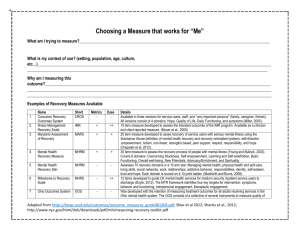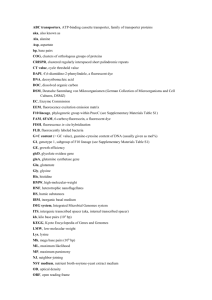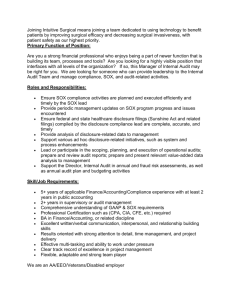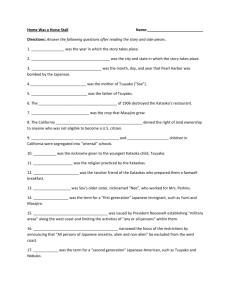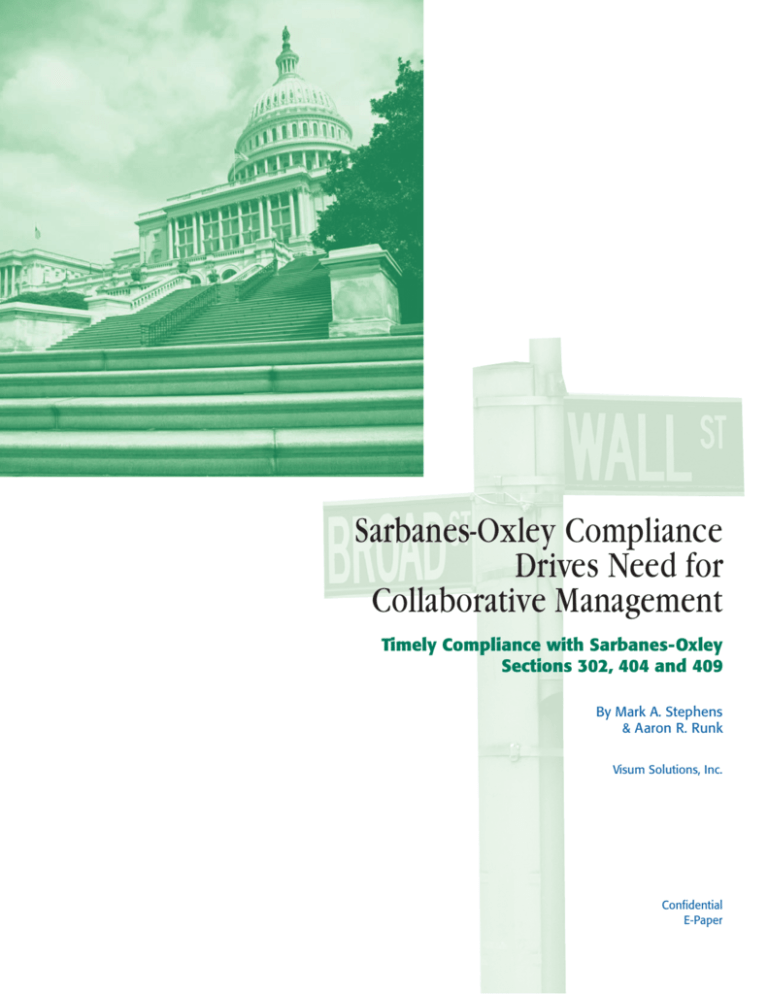
Sarbanes-Oxley Compliance
Drives Need for
Collaborative Management
Timely Compliance with Sarbanes-Oxley
Sections 302, 404 and 409
By Mark A. Stephens
& Aaron R. Runk
Visum Solutions, Inc.
Confidential
E-Paper
Introduction
After a string of corporate failures, see Enron, et al. The US Legislature passed the most sweeping
financial reporting rules and regulations ever enacted, the Sarbanes-Oxley (SOX) Act, July 2002.
In summary, the intention of the Act is to help restore public trust in US business and corporate
reporting. SOX requires public organizations (market capitalization of $75 M +) to more actively
report their current financial status.
Much of SOX deals with requirements for public accounting firms, detailing how they must
expand their current reporting procedures for firms they are auditing. However, there are also a
handful of sections that have specific requirements organizations must act upon. These sections,
in general, require target organizations to dynamically maintain and display business process and
performance information.
“Anybody who
thinks that we’re
going to come
back anytime soon
and amend the act
just simply hasn’t
followed the history
of the Congress.”
How can your organization build-up compliance with these complex new financial reporting rules?
And, more importantly, how can your organization get this capability in place in time? Three major
sections of SOX (302, 404 and 409) must be supported with technology, to both enable the
capturing of complex business financial information, and to speed the implementation to comply
with the required enactment dates.
In order to support SOX requirements by the deadline, avoiding any possible penalties and/or
criminal prosecution. We propose using a Collaborative Management Suite (CMS) and your business
financial reporting expertise. We will accomplish this by using QPR Software’s Collaborative
Management Software (ProcessGuide, ScoreCard, and Web Portal).
Further, using QPR’s Collaborative Management Software will enable your organization to more
effectively document and communicate process and performance information in general, greatly
enhancing the organization’s strategic effectiveness.
Business Effects
In a recent survey of Fortune 1000 companies by AMR Research, they found that:
Collaborative
Management
Software?
A combination of
process and business
performance reporting,
initiative and action
management, document
sharing, feedback
management, and
alerting which Gartner
has termed ”Collaborative
Management Software”.
• Fortune 1000 companies have earmarked more than $2.5B this year in Sarbanes-Oxley Act
investigation and initial compliance-related work
• 85% of companies predict that SOX will require changes in IT and application infrastructure
that support the business
• 79% are unsure what implications the act will have for their company
• 61% expect business process change will be required
• Importantly, many forward-thinking CIOs view Sarbanes-Oxley compliance as the
“compelling event” to kick-start specific system and process improvement initiatives long
stalled because of other IT spending priorities, thoughts that are reminiscent of the ERP
craze Y2K kicked off in the 1990s
Timelines and Penalties
Although the required enactment dates for SOX have slipped a bit, it looks like the legislature is
ready to start enforcing these rules. Current estimates are that much of SOX must be recognized
and reported by June 15, 2004. In our estimation, most public companies are nowhere near being
prepared to report this information.
Penalties as documented in SOX are severe for organizations not complying with the new reporting
rules, including the filing of fraud and obstruction of justice charges against all named officers of the
offending organization. SOX has criminal penalties for those who destroy records, commit
securities fraud and fail to report fraud, whereas it also provides protection for the whistleblowers.
S
O
L
U
T
I
O
N
S
Congressman John Oxley
© 2004 Visum Solutions, Inc.
All Rights Reserved.
2
SOX and Technology
What about Multinational
Corporations?
While the overall SOX act is very convoluted and complex, there are some
specific calls for action by target companies, and in turn opportunities for
technology to help support that action. There are two overall themes that
would be well supported with technology: business process mapping and
strategic theme reporting. These two themes are reflected in the following
three Sections of SOX:
The Act governs not only all the publicly traded
firms that list their stock on any US-based financial
exchange, but also any firm, irrespective of their place
of origin as long as they trade their stocks in the
United States.
25% of survey
Section 302 – Financial Reports
respondents say the
Title III – Corporate Responsibility - Section 302 – Financial Reports - states in part:
“[the signing officers] have designed such internal controls to insure that material information
relating to the issuer […] is made known to such officers by others within those entities,
particularly during the period in which the periodic reports are being prepared”
In other words, organizations must document the design and methodology of their financial
reporting process. Given the potential complexity of this process, with financial and other
information streaming from multiple sources, this requirement calls for the use of a powerful
business process modeling (BPM) software tool. This BPM tool must allow multiple users to design
and maintain the model, communicate the
model to interested parties inside and outside
the organization, and maintain this model in a
repository for future review.
Sarbanes-Oxley law
is “very confusing,”
according to an April
2003 Parsons Group
survey.
Financial Control
Process View
Part of our Collaborative Management Suite
includes QPR ProcessGuide, an interactive
software solution that commits people to
processes. ProcessGuide is a powerful, easy-to-
S
O
L
U
T
I
O
N
Reporting Procedures Process
Period Process Controls
3
S
Daily Process Controls
© 2004 Visum Solutions, Inc.
All Rights Reserved.
use, web-enabled tool that helps organizations realize the benefit of process and knowledge
management.
With QPR ProcessGuide, you have the ability to create multi-level process maps that can
accommodate even the most complex financial processes and make them understandable to
everyone inside and outside of your organization. Attach documents to process steps, collaborate
online, and even do dynamic simulation of your processes. The versatility of QPR ProcessGuide
makes for a powerful tool that will help you in your quest for SOX compliance.
Section 404 – Management Assessment and Reporting
of Internal Controls
Title IV – Enhanced Financial Disclosures – Section 404 – Management Assessment of
Internal Controls – states in part:
“[Each annual report shall contain an internal control report, which shall] contain an
assessment, as of the end of the most recent fiscal year of the issuer, of the effectiveness of the
internal control structure [of the organization]”
COSO
Simply put, companies must document their internal control structure, and communicate this
internal control structure as part of their annual report. Internal control structures have been
further defined and documented in various frameworks, including the popular COSO framework
(see inset).
Control Activities
• Assessment of a control
system’s performance
over time
• Combination of ongoing
and separate evaluation
• Management and
supervisory activities
• Internal audit activities
• Policies/procedures that
ensure management directives
are carried out
• Range of activities including
approvals, authorizations,
verifications, recommendations,
performance reviews, asset
security and segregation of duties
Information and Communication
Control Environment
Risk Assessment
• Pertinent information identified, captured
and communicated in a timely manner
• Access to internally and externally
generated information
• Flow of information that allows for
successful control actions from instructions
on responsibilities to summary of findings
for management action
• Sets tone of organization
influencing control
consciousness of its people
• Factors include integrity,
ethical values, competence,
authority, and responsibility
• Foundation for all other
components of control
• Risk assessment is the
identification and
analysis of relevant risks
to achieving the entity’s
objectives forming the
basis for determining
control activities
L
U
T
I
O
N
S
Monitoring
S
O
Once again, the QPR Collaborative Management Software easily supports this requirement by
seamlessly integrating QPR ProcessGuide and QPR ScoreCard. QPR ScoreCard is a completely
versatile, web-enabled software solution for automating any strategic performance management
system. By integrating these two powerful tools into one portal, we are able to complete the
Collaborative Management Suite and manage internal controls using the COSO framework.
© 2004 Visum Solutions, Inc.
All Rights Reserved.
4
Collaborative Management and COSO
Monitoring – Using the QPR Collaborative Management Software you are able to monitor your processes at every
level. With the ability to assign metrics to process steps and “drill down” to monitor performance, you will always
know how your processes are performing and when to make necessary adjustments.
Information & Communication – Using the QPR Portal as a repository for important documents allows for ondemand information that can be accessed internally or externally in a timely manner.
Control Activities – Policies and procedures can be built-in and published at ever step in your processes, along
with a documented verification process.
Control Environment – Because QPR’s Collaborative Management Software is a real-time environment, all
information is available to people in your organization on-demand in an understandable framework.
Risk Assessment – With the tool’s capability to do dynamic simulation of processes, you have the ability to assess
the risks associated with achieving your objectives.
S
O
Section 409 – Real Time Issuer Disclosures
L
Title IV – Enhanced Financial Disclosures – Section 409 – Real Time Issuer Disclosures – states in part:
U
T
“Each issuer reporting … shall disclose to the public on a rapid and current basis such additional
information concerning material changes in the financial condition or operations of the issuer, in
plain English, which may include trend and qualitative information and graphic presentations”
I
The key elements in this phrase are the disclosures of material financial change and the
requirement to disclose this information on a rapid and current basis. We interpret this as
meaning information must be disclosed as soon as it is discovered, not just as part of a standard
financial or annual report. This means your organization must (1) have access to material
financial information, and (2) be able to disclose this information on a rapid and current basis.
O
N
5
S
As amazing as it seems, it has been our experience that many organizations really have no idea how
they are performing financially or strategically in real-time. They have not taken the time to identify
©
© 2004
2004 Visum
Visum Solutions,
Solutions, Inc.
Inc
All Rights Reserved.
critical strategic elements in their organization, nor have they built them into an automated system
for constant review. Instead, most companies rely on paper systems to track and report this
information, often many months after the fact. This approach is simply not acceptable, nor
supportive of SOX requirements.
SCORECARDS
Financial Scorecard View
S
O
L
U
T
I
O
N
S
QPR Collaborative Management Software uses an intuitive web-based interface to communicate realtime critical financial and strategic information. Financial scorecards can be constructed with
measures that aid target-setting and performance measurement in areas critical to financial
performance and SOX compliance. Because of the flexibility and simplicity of maintaining multiple
“scorecards” in QPR ScoreCard, you are able to customize the application specifically for monitoring
section 409 metrics and disclose them in real-time. The performance management concept built
around “scorecards” supports planning and implementation by federating the actions of all parts of
an organization around a common understanding of its financial goals and requirements.
Financial Analysis View
© 2004 Visum Solutions, Inc.
All Rights Reserved.
6
Using the Briefing Booklet feature of the
QPR Collaborative Management Software
enhances the capability of an organization to
monitor its critical metrics and processes.
These dynamic Briefing Booklets are
reported in real-time or can be scheduled
and published on regular intervals —
making them ideal for internal viewing and
analysis or for external disclosure.
Furthermore, it is possible to set up e-mail
alerts to notify users immediately when a
metric changes, enters certain parameters, or
if values are missing. This idea of “Push
Technology” ensures that SOX initiatives and
requirements will not be overlooked.
Technology
Briefing Booklet
QPR Collaborative Management Software includes: QPR ScoreCard, a robust performance
management tool, QPR ProcessGuide, an easy to use multi-level process mapping and management
tool, and QPR Web Portal, an easy to use and customize web portal.
QPR ScoreCard users can view real-time strategy maps, hierarchical and analysis scorecards, as well
as individual measures. Users can also collaborate by writing comments, creating action plans,
lessons, and/or attaching documents.
QPR ProcessGuide is a comprehensive process mapping tool that allows users to create multi-level
process maps with the ability to attach documents and metrics to process steps, run dynamic
simulations, and collaborate by writing comments, action plans, and lessons. By seamlessly
integrating QPR ScoreCard and QPR ProcessGuide into one convenient portal, QPR has created the
most powerful collaborative management application on the market today.
Easy to use: QPR ScoreCard and QPR ProcessGuide can have an unrestricted amount of
simultaneous users in dispersed locations. This means that users can view changes in a model
immediately. User rights can be individually set and defined.
Web-enabled: QPR ScoreCard and QPR ProcessGuide are completely web-enabled software that
supports information deployment via a browser and can therefore be used as an enterprise-wide system.
meet these new
regulations, many
will look to technology
solutions to support
an overall financial
compliance strategy.”
L
Sarbanes-Oxley is no longer a future possibility, but is now a current reality. If your organization
falls into the target for SOX, then you probably already know the enforcement dates and penalties
for non-compliance.
U
T
There are three SOX sections that require your organization to map business processes and
communicate financial performance. These requirements must be supported with technology
(not just consulting) that allows for the automation of business process information and the
communication of near-real-time financial changes.
I
O
QPR Collaborative Management Software is the perfect set of software tools to support these
requirements, with process mapping and performance visualization capabilities built into a
single end-user interface. With our suite, not only can you comply with SOX requirements,
but you can also map and communicate your entire strategic direction, supporting
your organizations future by helping communicate strategic effectiveness now
and in the future.
N
S
7
O
Henry Morris, Group VP
for Applications &
Information Access at IDC
“Sarbanes-Oxley: A Catalyst
for a New Category of
Analytic Applications?”
April 2003
S
Conclusion
“As CFOs prepare to
© 2004 Visum Solutions, Inc.
All Rights Reserved.
“Many firms will utilize the Sarbanes-Oxley Act as a means of improving
business efficiency, going beyond what is merely required to comply”
META Group Inc.
VISUM SOLUTIONS, INC.
5001 American Boulevard West, Suite 655
Bloomington, MN 55437
tel: 952.835.4131
fax: 952.835.5412
sales@visumsolutions.com
www.visumsolutions.com

